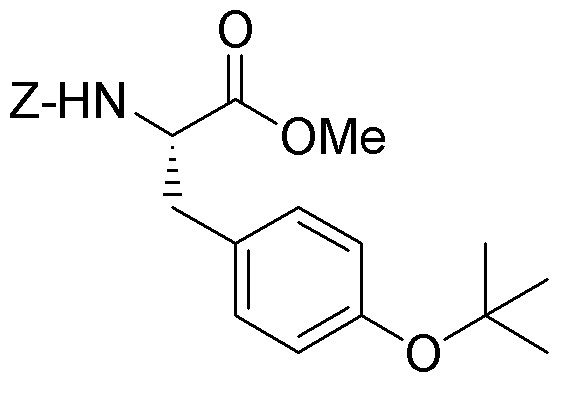Z-O-tert-butyl-L-tyrosine methyl ester is widely utilized in research focused on:
- Peptide Synthesis: This compound serves as a protecting group in the synthesis of peptides, allowing for selective reactions that enhance the efficiency and yield of the final product.
- Drug Development: It plays a crucial role in the pharmaceutical industry for designing and optimizing drug candidates, particularly those targeting neurological disorders due to its structural similarity to neurotransmitters.
- Bioconjugation: Researchers use it to facilitate the attachment of biomolecules, such as proteins or antibodies, to therapeutic agents, improving the specificity and efficacy of treatments.
- Analytical Chemistry: This compound is employed in various analytical techniques, including chromatography, to separate and identify complex mixtures, aiding in quality control processes.
- Cosmetic Formulations: It is also found in cosmetic products for its potential antioxidant properties, contributing to skin health and protection against environmental stressors.
General Information
Properties
Safety and Regulations
Applications
Z-O-tert-butyl-L-tyrosine methyl ester is widely utilized in research focused on:
- Peptide Synthesis: This compound serves as a protecting group in the synthesis of peptides, allowing for selective reactions that enhance the efficiency and yield of the final product.
- Drug Development: It plays a crucial role in the pharmaceutical industry for designing and optimizing drug candidates, particularly those targeting neurological disorders due to its structural similarity to neurotransmitters.
- Bioconjugation: Researchers use it to facilitate the attachment of biomolecules, such as proteins or antibodies, to therapeutic agents, improving the specificity and efficacy of treatments.
- Analytical Chemistry: This compound is employed in various analytical techniques, including chromatography, to separate and identify complex mixtures, aiding in quality control processes.
- Cosmetic Formulations: It is also found in cosmetic products for its potential antioxidant properties, contributing to skin health and protection against environmental stressors.
Documents
Safety Data Sheets (SDS)
The SDS provides comprehensive safety information on handling, storage, and disposal of the product.
Product Specification (PS)
The PS provides a comprehensive breakdown of the product’s properties, including chemical composition, physical state, purity, and storage requirements. It also details acceptable quality ranges and the product's intended applications.
Certificates of Analysis (COA)
Search for Certificates of Analysis (COA) by entering the products Lot Number. Lot and Batch Numbers can be found on a product’s label following the words ‘Lot’ or ‘Batch’.
Numéro de catalogue
Numéro de lot/série
Certificates Of Origin (COO)
This COO confirms the country where the product was manufactured, and also details the materials and components used in it and whether it is derived from natural, synthetic, or other specific sources. This certificate may be required for customs, trade, and regulatory compliance.
Numéro de catalogue
Numéro de lot/série
Safety Data Sheets (SDS)
The SDS provides comprehensive safety information on handling, storage, and disposal of the product.
DownloadProduct Specification (PS)
The PS provides a comprehensive breakdown of the product’s properties, including chemical composition, physical state, purity, and storage requirements. It also details acceptable quality ranges and the product's intended applications.
DownloadCertificates of Analysis (COA)
Search for Certificates of Analysis (COA) by entering the products Lot Number. Lot and Batch Numbers can be found on a product’s label following the words ‘Lot’ or ‘Batch’.
Numéro de catalogue
Numéro de lot/série
Certificates Of Origin (COO)
This COO confirms the country where the product was manufactured, and also details the materials and components used in it and whether it is derived from natural, synthetic, or other specific sources. This certificate may be required for customs, trade, and regulatory compliance.


